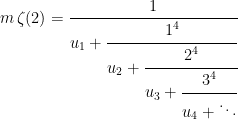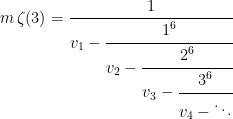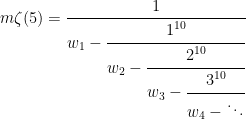It seems there is a nice “pattern” between the continued fractions for the Riemann zeta function,

at s = 2, and s = 3. First though, a little introduction.
The origins of this function go back to 1644 when, at the tender age of 18, the Italian mathematician Pietro Mengoli (1626-1686) first proposed what would be later known as the Basel Problem, namely to determine the exact value of the sum of the reciprocals of the squares. Euler would later find that, for n a positive integer, then  is a rational multiple of
is a rational multiple of  , with the first case s = 2 as,
, with the first case s = 2 as,

which obviously is irrational. However, the status of odd s was not as easy to resolve. It was only in 1979 that Apery proved that  is irrational, which henceforth was called Apery’s constant.
is irrational, which henceforth was called Apery’s constant.
I. Zeta(2)
One of its infinite number of continued fractions can be given as,

where  and the
and the  , starting with n = 1, are generated by,
, starting with n = 1, are generated by,

or simply the odd numbers. The convergence is slow, but Apery found it can accelerated by using a quadratic function,

but now  .
.
II. Zeta(3)
Likewise, this also has an infinite number of continued fractions (see Ramanujan’s versions here), but one important form is,

where  and the
and the  , again starting with n = 1, are,
, again starting with n = 1, are,

Apery again found an accelerated version,

where now  , and established that its rate of convergence was such that
, and established that its rate of convergence was such that  could not be a ratio of two integers.
could not be a ratio of two integers.
III. Connection between Zeta(2) and Zeta(3)
Define the two sequences,


then it was established that these Apery numbers have the recurrence relations,


Interesting that the same polynomials pop up, isnt’ it? Furthermore, their limiting ratios have the common form,

thus for b = 1, 2,


hence the golden ratio and the silver ratio surprisingly turn up in the continued fractions for  and
and  , respectively. It is easy to check other sequences,
, respectively. It is easy to check other sequences,

for some small {p, q}, but there are no other recurrence relations similar in form to the two above.
IV. Zeta(5)
There is an orderly non-simple continued fraction for all  , with the next odd s as,
, with the next odd s as,

where  and the
and the  are,
are,

Unfortunately, no one has yet found an accelerated version where the  are generated by a 5th degree (or higher) polynomial, and m is rational.
are generated by a 5th degree (or higher) polynomial, and m is rational.
Can you find one?
For further reading, refer to Alfred van der Poorten’s excellent, A Proof That Euler Missed.
is the j-function,
,
, and
. Since it is known that,
, hence
. Then,
